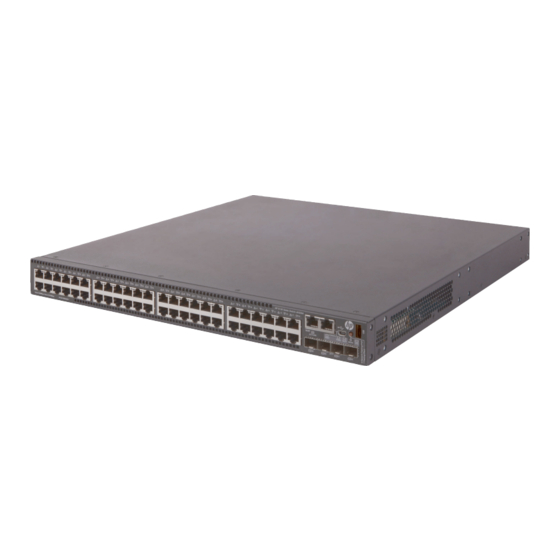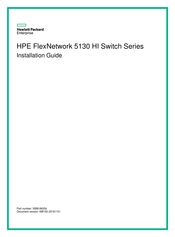
HPE FlexNetwork 5130 HI SERIES Manuals
Manuals and User Guides for HPE FlexNetwork 5130 HI SERIES. We have 5 HPE FlexNetwork 5130 HI SERIES manuals available for free PDF download: Network Management And Monitoring Command Reference, Configuration Manual, Installation Manual
HPE FlexNetwork 5130 HI SERIES Network Management And Monitoring Command Reference (378 pages)
Table of Contents
-
-
Debugging10
-
Ping11
-
Ping Ipv614
-
Tracert16
-
Tracert Ipv617
-
-
NQA Commands
19-
-
Codec-Type19
-
Data-Fill21
-
Data-Size22
-
Description23
-
Expect Data46
-
Expect Ip47
-
Expect Ipv647
-
Filename49
-
Frequency49
-
Init-Ttl52
-
Lsr-Path53
-
Max-Failure53
-
Mode54
-
Next-Hop Ip55
-
Nqa57
-
Nqa Schedule58
-
Nqa Template59
-
Password62
-
Probe Count63
-
Raw-Request67
-
Resolve-Type82
-
Source Ip84
-
Source Ipv685
-
Source Port86
-
Target-Only89
-
Tos90
-
Ttl90
-
Type91
-
Url92
-
Username93
-
Version94
-
-
NTP Commands
99-
Ntp-Service Acl111
-
Ntp-Service Dscp116
-
SNTP Commands
132 -
Poe Commands
139-
Display Poe Pse146
-
Poe Enable154
-
Poe Enable Pse154
-
Poe Max-Power155
-
Poe Priority157
-
Poe Update158
-
Poe-Profile159
-
SNMP Commands
161-
Snmp-Agent177
-
Snmp-Agent Group184
-
Snmp-Agent Log187
-
Snmp-Agent Port189
-
RMON Commands
206-
Rmon Alarm214
-
Rmon Event216
-
Rmon History217
-
Rmon Prialarm218
-
Rmon Statistics220
-
NETCONF Commands
222 -
CWMP Commands
232-
Cwmp232
-
Cwmp Acs Url235
-
Cwmp Enable244
-
-
EAA Commands
248-
Action Cli248
-
Action Reboot249
-
Action Syslog250
-
Commit251
-
Event Cli254
-
Event Hotplug255
-
Event Interface256
-
Event Process258
-
Event Snmp Oid259
-
Event Syslog261
-
Event Track262
-
Rtm Cli-Policy263
-
Rtm Environment264
-
Rtm Tcl-Policy266
-
Running-Time267
-
User-Role268
-
-
-
Display Process288
-
Monitor Process304
-
Monitor Thread309
-
Process Core312
Advertisement
HPE FlexNetwork 5130 HI SERIES Configuration Manual (218 pages)
Brand: HPE
|
Category: Network Router
|
Size: 2 MB
Table of Contents
Advertisement
HPE FlexNetwork 5130 HI SERIES Installation Manual (76 pages)
Table of Contents
-
Emi7
-
Symptom44
-
Solution44
-
No Display46
-
Ports58
-
Console Port58
-
USB Port58
-
SFP+ Port59
HPE FlexNetwork 5130 HI SERIES Installation Manual (76 pages)
Table of Contents
-
Emi7
-
Symptom44
-
Solution44
-
No Display46
-
Ports58
-
Console Port58
-
USB Port58
-
SFP+ Port59
Advertisement




